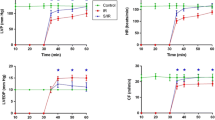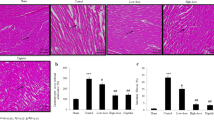Abstract
This study was designed to investigate whether the pretreatment with curcumin, a yellow pigment from turmeric (Curcuma longa) known for its potent antioxidant capacity, was able to protect against the oxidant damage and mitochondrial dysfunction induced by reperfusion injury in isolated hearts. Rats were treated with a daily intragastric dose of curcumin (200 mg/kg) for 7 days prior to experimental ischemia (30 min) and reperfusion (60 min) (I/R). Cardiac mechanical work was measured during periods of stabilization, ischemia, and reperfusion. Oxidant stress and activity of antioxidant enzymes were measured in both homogenates of cardiac tissue and in isolated mitochondria. In addition, oxygen consumption was measured in isolated mitochondria. It was found that curcumin pretreatment attenuates the I/R injury as evidenced by (a) loss of cardiac mechanical work, (b) oxidant stress (increase in lipid peroxidation and decrease in reduced glutathione content) and (c) decrease in the activity of the antioxidant enzymes superoxide dismutase and glutathione reductase in both cardiac tissue and isolated mitochondria, and (d) decrease in mitochondrial respiratory capacity. In conclusion, the protective effect of curcumin was associated with the attenuation of oxidant stress and mitochondrial dysfunction secondary to I/R injury.



Similar content being viewed by others
References
Aggarwal, B. B., Sundaram, C., Malani, N., & Ichikawa, H. (2007). Curcumin: the Indian solid gold. Advances in Experimental Medicine and Biology, 595, 1–75.
Krishnaswamy, K. (2008). Traditional Indian spices and their health significance. Asia Pacific Journal of Clinical Nutrition, 17, 265–268.
Sharma, O. P. (1976). Antioxidant activity of curcumin and related compounds. Biochemical Pharmacology, 25, 1811–1812.
Toda, S., Miyase, T., Arichi, H., Tanizawa, H., & Takino, Y. (1985). Natural antioxidants. III. Antioxidative components isolated from rhizome of Curcuma longa L. Chemical and Pharmaceutical Bulletin (Tokyo), 33, 1725–1728.
Satoskar, R. R., Shah, S. J., & Shenoy, S. G. (1986). Evaluation of anti-inflammatory property of curcumin (diferuloylmethane) in patients with postoperative inflammation. International Journal of Clinical Pharmacology, Therapy and Toxicology, 24, 651–654.
Negi, P. S., Jayaprakasha, G. K., Jagan Mohan Rao, L., & Sakariah, K. K. (1999). Antibacterial activity of turmeric oil: A byproduct from curcumin manufacture. Journal of Agriculture and Food Chemistry, 47, 4297–4300.
Kuttan, R., Bhanumathy, P., Nirmala, K., & George, M. C. (1985). Potential anticancer activity of turmeric (Curcuma longa). Cancer Letters, 129, 197–202.
Reddy, A. C., & Lokesh, B. R. (1994). Studies on the inhibitory effects of curcumin and eugenol on the formation of reactive oxygen species and the oxidation of ferrous iron. Molecular and Cellular Biochemistry, 137, 1–8.
Unnikrishnan, M. K., & Rao, M. N. (1995). Curcumin inhibits nitrogen dioxide induced oxidation of hemoglobin. Molecular and Cellular Biochemistry, 146, 35–37.
Sreejayan, N., & Rao, M. N. (1997). Nitric oxide scavenging by curcuminoids. Journal of Pharmacy and Pharmacology, 49, 105–107.
Prestera, T., & Talalay, P. (1995). Electrophile and antioxidant regulation of enzymes that detoxify carcinogens. Proceedings of the National Academy of Sciences of the United States of America, 92, 8965–8969.
Susan, M., & Rao, M. N. (1992). Induction of glutathione S-transferase activity by curcumin in mice. Arzneimittelforschung, 42, 962–964.
Dinkova-Kostova, A. T., & Talalay, P. (1999). Relation of structure of curcumin analogs to their potencies as inducers of Phase 2 detoxification enzymes. Carcinogenesis, 20, 911–914.
Mythri, R. B., Jagatha, B., Pradhan, N., Andersen, J., & Bharath, M. M. (2007). Mitochondrial complex I inhibition in Parkinson’s disease: How can curcumin protect mitochondria? Antioxidants & Redox Signaling, 3, 399–408.
Wei, Q., Chen, W., Zhou, B., Yang, L., & Liu, Z. (2006). Inhibition of lipid peroxidation and protein oxidation in rat liver mitochondria by curcumin and its analogues. Biochimica et Biophysica Acta, 1760, 70–77.
Rastogi, M., Rudra Ojha, P., Rajamanickam, G. V., Agrawal, A., Aggarwal, A., & Dubey, G. P. (2008). Curcuminoids modulates oxidative damage and mitochondrial dysfunction in diabetic rat brain. Free Radical Research, 42, 999–1005.
Nazam, A. M., Thakare, V. N., Bhandari, U., & Pillai, K. K. (2007). Protective role of curcumin in myocardial oxidative damage induced by isoproterenol in rats. Human and Experimental Toxicology, 26, 933–938.
Naik, S. R., & Patil, S. R. (2011). Protective effect of curcumin on experimentally induced inflammation, hepatotoxicity and cardiotoxicity in rats: Evidence of its antioxidant property. Experimental and Toxicologic Pathology, 63, 419–431.
Chen, Q., Camara, A. K., Stowe, D. F., Hoppel, C. L., & Lesnefsky, E. J. (2007). Modulation of electron transport protects cardiac mitochondria and decreases myocardial injury during ischemia and reperfusion. American Journal of Physiology. Cell Physiology, 292, C137–C147.
Di Lisa, F., Canton, M., Menabo, R., Kaludercic, N., & Bernardi, P. (2007). Mitochondria and cardioprotection. Heart Failure Reviews, 12, 249–260.
Lesnefsky, E. J., Slabe, T. J., Stoll, M. S., Minkler, P. E., & Hoppel, C. L. (2001). Myocardial ischemia selectively depletes cardiolipin in rabbit heart subsarcolemmal mitochondria. American Journal of Physiology. Heart and Circulatory Physiology, 280, H2770–H2778.
Chen, Q., Vazquez, E. J., Moghaddas, S., Hoppel, C. L., & Lesnefsky, E. J. (2003). Production of reactive oxygen species by mitochondria: central role of complex III. Journal of Biological Chemistry, 278, 36027–36031.
Chambers, D. E., Parks, D. A., Patterson, G., Roy, R., McCord, J. M., Yoshida, S., et al. (1985). Xanthine oxidase as a source of free radical damage in myocardial ischemia. Journal of Molecular and Cellular Cardiology, 17, 145–152.
Misra, M. K., Sarwat, M., Bhakuni, P., Tuteja, R., & Tuteja, N. (2009). Oxidative stress and ischemic myocardial syndromes. Medical Science Monitor, 15, 209–219.
Correa, F., Garcia, N., Robles, C., Martinez-Abundis, E., & Zazueta, C. (2008). Relationship between oxidative stress and mitochondrial function in the post-conditioned heart. Journal of Bioenergetics and Biomembranes, 40, 599–606.
Correa, F., Soto, V., & Zazueta, C. (2007). Mitochondrial permeability transition relevance for apoptotic triggering in the post-ischemic heart. International Journal of Biochemistry and Cell Biology, 39, 787–798.
Maldonado, P. D., Barrera, D., Medina-Campos, O. N., Hernández-Pando, R., Ibarra-Rubio, M. E., & Pedraza-Chaverrí, J. (2003). Aged garlic extract attenuates gentamicin induced renal damage and oxidative stress in rats. Life Sciences, 73, 2543–2556.
Lowry, O. H., Rosebrough, N. J., Farr, A. L., & Randall, R. J. (1951). Protein measurement with the Folin phenol reagent. Journal of Biological Chemistry, 193, 265–275.
Fernández-Checa, J. C., & Kaplowitz, N. (1990). The use of monochlorobimane to determine hepatic GSH levels and synthesis. Analytical Biochemistry, 190, 212–219.
Guerrero-Beltrán, C. E., Calderón-Oliver, M., Tapia, E., Medina-Campos, O. N., Sánchez-González, D. J., Martínez-Martínez, C. M., et al. (2010). Sulforaphane protects against cisplatin-induced nephrotoxicity. Toxicology Letters, 192, 278–285.
Barrera, D., Maldonado, P. D., Medina-Campos, O. N., Hernández-Pando, R., Ibarra-Rubio, M. E., & Pedraza-Chaverri, J. (2003). HO-1 induction attenuates renal damage and oxidative stress induced by K2Cr2O7. Free Radical Biology and Medicine, 34, 1390–1398.
Aebi, H. (1984). Catalase in vitro. Methods in Enzymology, 105, 121–126.
Pedraza-Chaverri, J., Yam-Canul, P., Chirino, Y. I., Sánchez-González, D. J., Martínez-Martínez, C. M., Cruz, C., et al. (2008). Protective effects of garlic powder against potassium dichromate-induced oxidative stress and nephrotoxicity. Food and Chemical Toxicology, 46, 619–627.
Chávez, E., Briones, R., Michel, B., Bravo, C., & Jay, D. (1985). Evidence for the involvement of dithiol groups in mitochondrial calcium transport: Studies with cadmium. Archives of Biochemistry and Biophysics, 242, 293–397.
Zweier, J. L., Flaherty, J. T., & Weisfeldt, M. L. (1987). Direct measurement of free radical generation following reperfusion of ischemic myocardium. Proceedings of the National Academy of Science, 84, 1404–1407.
Duda, M., Konior, A., Klemenska, E., & Beręsewicz, A. (2007). Preconditioning protects endothelium by preventing ET-1-induced activation of NADPH oxidase and xanthine oxidase in post-ischemic heart. Journal of Molecular and Cellular Cardiology, 42, 400–410.
Cross, H., Opie, L., Radda, G., & Clarke, K. (1996). Is high glycogen content beneficial or detrimental to the ischemic rat heart? A controversy resolved. Circulation Research, 78, 482–491.
Dennis, S., Gevers, W., & Opie, L. (1991). Protons in ischemia: where do they come from: Where do they go? Journal of Molecular and Cellular Cardiology, 23, 1077–1086.
Ambrosio, G., Zweier, J., Duilio, C., Kuppusamy, P., Sanoro, G., Elia, P., et al. (1993). Evidence that mitochondrial respiration is a source of potentially toxic oxygen free radicals in intact rabbit hearts subjected to ischemia and reflow. Journal of Biological Chemisty, 268, 18532–18541.
Yeh, C. H., Wu, Y. C., & Jing, L. P. (2005). Inhibition of NFkappaB activation with curcumin attenuates plasma inflammatory cytokines surge and cardiomyocytic apoptosis following cardiac ischemia/reperfusion. Journal of Surgical Research, 125, 109–116.
Acknowledgments
This work was supported by PAPIIT IN201910 and CONACYT 129838 (to JP) and CONACYT 80791 (to CZ).
Author information
Authors and Affiliations
Corresponding authors
Additional information
Alfredo González-Salazar and Eduardo Molina-Jijón contributed equally to this work.
Rights and permissions
About this article
Cite this article
González-Salazar, A., Molina-Jijón, E., Correa, F. et al. Curcumin Protects from Cardiac Reperfusion Damage by Attenuation of Oxidant Stress and Mitochondrial Dysfunction. Cardiovasc Toxicol 11, 357–364 (2011). https://doi.org/10.1007/s12012-011-9128-9
Published:
Issue Date:
DOI: https://doi.org/10.1007/s12012-011-9128-9




